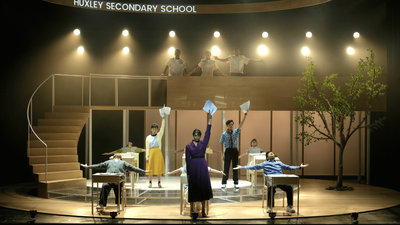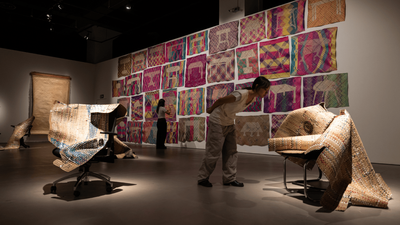On the black vinyl floor, a thin layer of grey shimmers gently. Under this translucent fabric, a silhouette: curved, foetal, hidden from our view—for now. Moments before crossing the theatre’s threshold, Johari Kazura from Sifr Aromatics greets us at the front-of-house with scents created just for “REFUGE”. They’re meant to evoke the damp of forest floor mulch and the pungent musk of animal droppings. After talking us through these olfactory layers, he offers to dab the perfume on our wrists. As I await “REFUGE’s” arrival in the dark womb of School of the Arts’ Studio Theatre, wisps of petrichor carried by my fellow journeyers drift through my nasal cavity, conjuring images of musty caves and fluttering bats.
Throughout the hour-long performance by The Observatory, an experimental local band whose commitment is to make “music for a new world”, I’m acutely conscious of time—and a sense of journeying someplace I’ve never been, as well as its associated risks. Even now, the show’s timelines glitch, breaking the linear temporal logic of my memory.
When it comes to time, there is “shallow” time, and “deep” time. Shallow time is what we’re most intimate with. It is experienced as 24-hour cycles, the seconds ticking by as you read this. Deep time, on the other hand, refers to time on the scale of rock formations and evolutionary processes, a scale that stretches far beyond a human lifespan. It is a time that embodies all 4.6 billion years of Earth’s history. As I stand, sit, then sprawl on the theatre floor, I feel myself transforming into a cave-dwelling creature, sensitive to all light and sounds, and blind to the shallow time of the outside world.
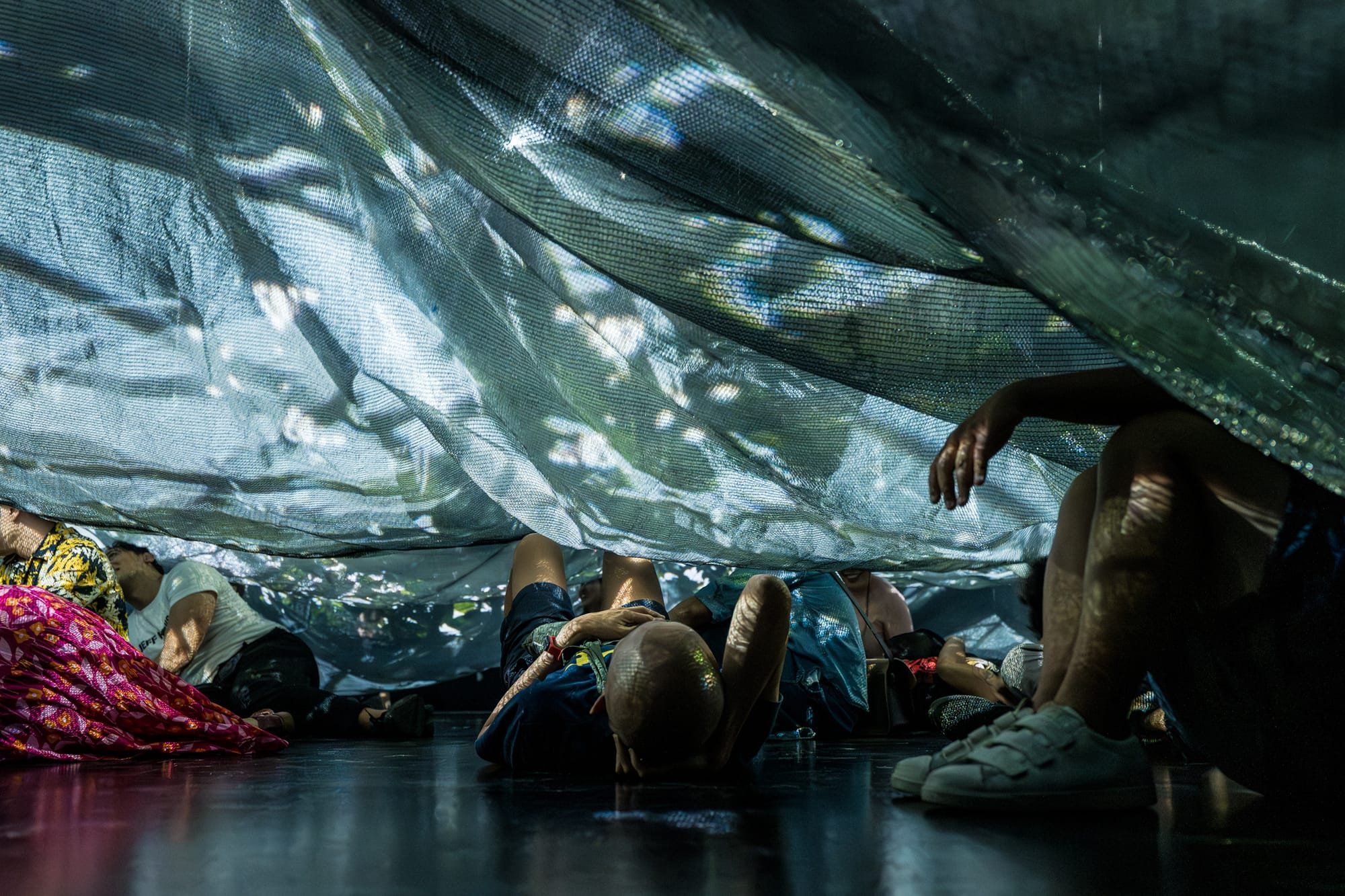
“REFUGE” was birthed from The Observatory’s multiple research trips into the caves of Lenggong Valley in Perak, Malaysia, and it’s been described as a “metaphysical sojourn into the subterranean”.
Established in 2001, The Observatory has gone through several iterations. Its current constellation comprises Dharma and Yuen Chee Wai on guitars, effects and objects, and Cheryl Ong on drums and electronics. For “REFUGE”, they worked across visual art, moving image and performance to create a work that exceeds what we typically expect of a music performance, transforming it into a multisensory experience.
They’ve also involved collaborators from different parts of the world. Rully Shabara, a Yogyakarta-based artist and vocalist of the Indonesian experimental duo Senyawa, brings extensive vocal techniques and an intimate knowledge of traditional Indonesian music, while Ruengrith Suntisuk (Ton) and Pornpan Arayaveerasid (Ching) of DuckUnit, a Thai collective, sensitively craft a spatial environment through lighting and scenography that both responds to and holds the audience throughout the hour-long performance. Justin Shoulder, an Australian movement artist, embodies a bionic creature featured in its moving image portion.
Given this international configuration, “REFUGEs”’s birth, led by sound and music, was both asynchronous and emergent. The team took research trips together, visiting caves and filming footage for the show’s moving image portions, and working together remotely to assemble it.
Out of the dozens of known caves in Lenggong Valley, The Observatory chose to do a deep dive into Gua Gunung Runtuh, where the “Perak Man” was excavated, in 1991. The “Perak Man” is the oldest and most complete human skeleton found in South-east Asia and dates back about 10 thousand years. Perak is also the hometown of Dharma, the band’s guitarist, which was one of The Observatory’s entry points to the Valley. Video footage from these research trips; audio-visual projections of myths, murders and the “Perak Man”; and the voice of En Rosli, the band’s local guide: all of these elements eventually set the stage in the opening act of the show.
As astounding as the discovery of the “Perak Man” was, Gua Gunung Runtuh isn’t the only archaeologically significant cave in the vicinity. Just a four-hour drive away, in Nenggiri Valley, more traces of pre-Neolithic culture have been found. However, limestone-processing factories have mushroomed in the area to meet a consistent demand for cement (and sand), perhaps quicker than these prehistoric traces can be properly excavated. The surge in quarrying activities, such as cave blasting, has accelerated the deterioration.
Singapore contributes significantly to both this deterioration by importing a large proportion of its sand and cement from Malaysia. In fact, Singapore is one of the largest importers of sand in the world, according to a 2019 United Nations Environment Programme report on sand sustainability, with no signs of slowing down. Just last year, the Urban Development Agency announced a Draft Masterplan 2025 to reclaim more land along the East Coast. They’re hoping to build a ‘Long Island’ for “future development needs” and “new recreational opportunities”. It wouldn’t be far-fetched to say that the very buildings we live in and the roads we walk on probably have traces of the prehistoric embedded within them. The shallow time of our hyper-capitalist, extractive world is studded with traces of the deep.
There is a romance to being known. But there is also a risk for a violence that comes with being known intimately. The exhilarations and perils of discovery, and being discovered, can occur on both micro and macro scales. Quarrying, housing development, graffiti, curious and careless visitors drawn to the “Perak Man” discovery—all of these things, according to the UNESCO (United Nations Educational, Scientific and Cultural Organization), promise developmental riches but can also pose devastating risks to Lenggong Valley.
As I take shelter in the timewarp of “REFUGE”, I wonder: what does it mean to be excavated, to become legible and known? Does it bring danger, putting that which is discovered at risk? Singaporean playwright Nabilah Said’s new play “Territori” asks similar questions about the resource-rich and remote Christmas Island. The legibility and visibility of the island’s people and its minerals comes with the risk of being co-opted and coerced into cultural and economic extraction. The act of witnessing is not as simple as just looking at something; it comes with recognising it as valuable and, through that, the possibility of rousing desires and greed. There is such a precarious line between the excitement of being known and risking exposure. How can we show the soft parts of ourselves and be certain that what we share will be treated with care?
The Observatory and its collaborators make me conscious of how I move around in the space, both cautious and curious. Here, I am implicated as both cave visitor—and cave-dweller. Like how “REFUGE” dances between cocooning us in deep time and reminding us of the present time through wafts of musk still lingering on our wrists, our material world is laced with traces of geological time. My experience as an audience member flits between the thrills and terrors of exposure, both as the excavator and the excavated.
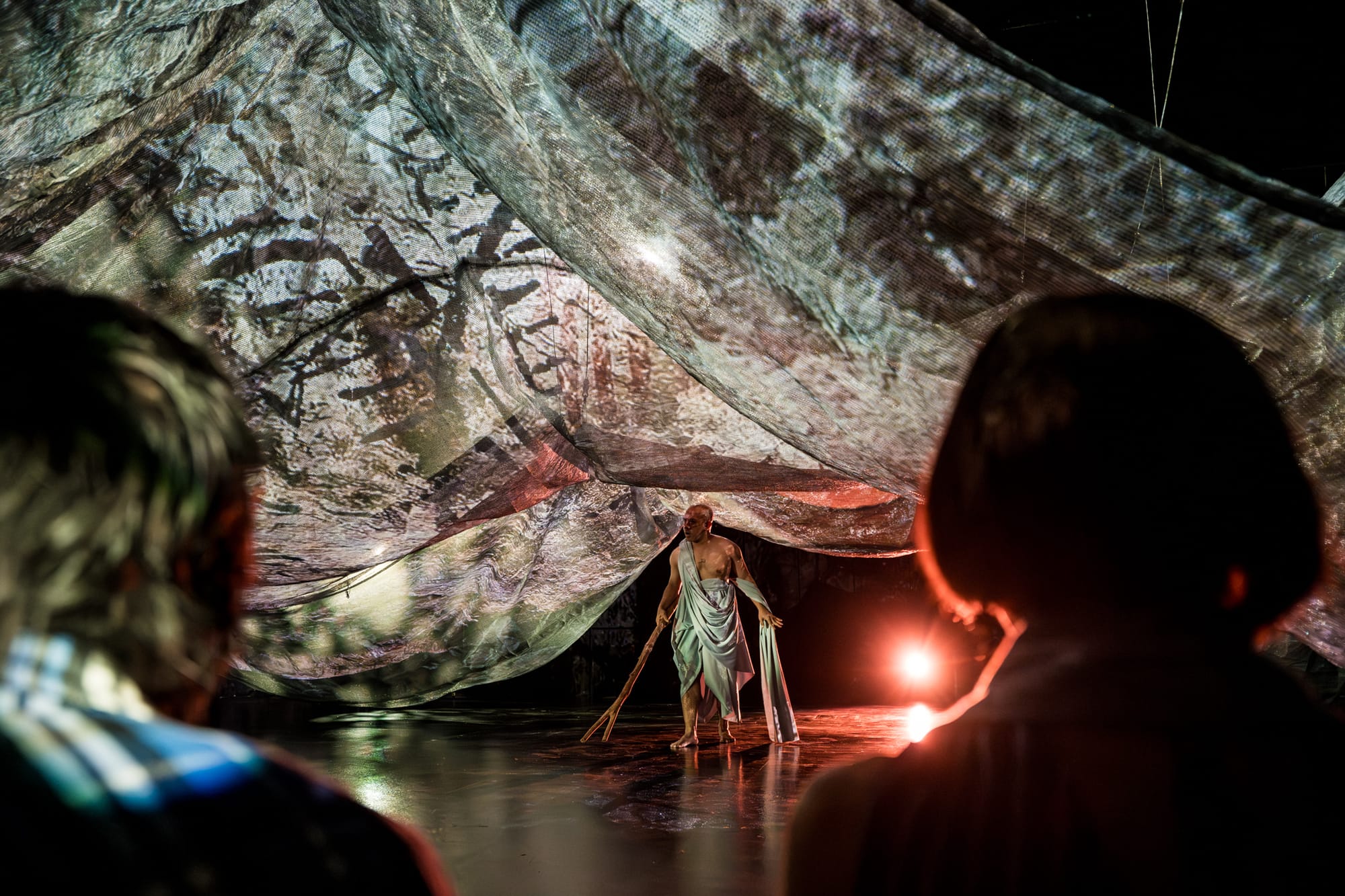
The lights dim, so imperceptibly, that I don’t notice until the theatre is almost pitch-black. Some of us audience members have opted to sit at the edge of the grey fabric, and without warning, the shimmery canopy lifts. From pure reflex, some of us closest to the edge start scuttling away, like frantic insects dispersing when an unexpected visitor enters their cave home. But who is the intruder here? I pause, before inching away, waiting for the opening between fabric and floor to be large enough so that I can slip under it. I hesitate: do I stay, or do I move? Does it feel safe for me to come into contact with this shimmery, silvery grey? I pause, reaching out to feel the coarse material, before placing my hands on the cool floor and scooting back.
This shimmering grey fabric is, in fact, a huge piece of shade net, typically used as a crop cover to protect plants from the life-giving (but also life-taking) sun. In DuckUnit’s deft hands, the shade net morphs into different terrains—catacombs, cave, womb. We are invited to not only touch the material, but also to “allow the material to touch [us],” says producer Deanna Dzulkifli at the front-of-house briefing. A few caveats: please do not step on, or pull at, the net. In other words: you are welcome to engage with the material—but with care, please.
The hidden silhouette that is Rully Shabara rouses. He seems to stumble, disoriented, as he surveys the ground. Rully is a shamanic presence, accompanied by a time-smoothened wooden branch. From deep within his throat, a resonant voice, seemingly guttural from disuse, emerges. Is he the “Perak Man”? Is his disorientation a response to the sudden violence of being forced under the light’s glare for the first time in millennia? Rully feels his way around us, guided by the branch that seems as ancient, if not more, than him. What makes some of us stay put, and what makes some of us move? What are our risk thresholds when we come into contact with the unknown? What are the barriers we’ve put in place that protect us—but also bar us from experiencing the surprise of beauty? My mind starts to spin from these relentless questions as I try to orient myself in this new world that “REFUGE” has created.
Rully’s physical presence isn’t the only surprise we must negotiate in “REFUGE”. The show’s discordant sounds feel, at times, like sharp debris flung against my eardrums, and at other times symbolic of the atrophy that will befall all matter. Integrated within the synth soundscape are the new and uncanny bionic sounds Rully has generated on Xhabarabot Voice Machines using audio data from his voice. Screeches resembling screaming bats puncture the air, at once organic and industrial, at times rounded out by Dharma and Chee Wai’s manipulation of field recordings into synthetic slivers of miditones. All this while, Cheryl’s persistent rhythms drill into my ears. These elements zigzag through the air and saturate my senses, the only thing I can concretely recall now is a sense of being overwhelmed. My body curls into itself, palms reaching towards the floor for a sense of grounding. Meanwhile, projections above my head depict ancient cave drawings, and doodles of simplistic shapes and symbols.
Just as I am about to cross a sensorial and emotional threshold, I’m propelled towards a single note with a frequency so high I think it’s my tinnitus acting up. The lights dim again, and a sense of calm floods the space as all becomes quiet and dark. I remain close to the ground, and lift my head to small specks of white light twinkling above. They feel like stars. I’m flat on the ground, feeling as though I am awaiting rebirth or something vaguely transformational. Is this how the “Perak Man” felt moments before his death, or moments after his discovery after thousands of years?
I lift my head, preparing to sit up—thinking the performance over—and suddenly the space is scratched awake by Cheryl working the rhythmic heart of the room. Dharma and Chee Wai mould the soundscape into a frenzy with industrial sounds akin to bulldozers breaking into stones, layered with the insistent repetition of what sounds like cicadas singing. When I was preparing for the show and the “metaphysical sojourn” it promised, I decided to draw a tarot card as a touchstone for myself. Out came the Five of Pentacles, a card typically associated with poverty and the struggle to stay afloat while searching for relief. But there’s also hope implicit in this card: there will be a respite after being put through the wringer. Anticipating another sensory onslaught, I remember the promise of the card and tell myself that if I stay still, and remain sensitive to my surroundings, it’ll be worth it. So I lie back down, sheltered by the shade net that’s both fence and fort.
Sure enough, the shade net seems to come alive, moving and responding to my touch. As I reach out to meet it with my palm, I feel it pulling away, the distance between us growing until we are no longer in contact, leaving my hands outstretched, waiting for its return. As it rises and falls above us, I find myself breathing in tandem with it. Once, when it comes close enough, I flick my wrist, feeling the movement create a series of ripples, which breaks on the skin of someone seated, upright, next to me as I remain supine. I look around and catch the eye of someone else, a woman who’d seen me playing with the material, and we exchange mischievous looks. She, too, lifts her hand, causing gentler waves in the fabric as the soundscape drones on. We are both similarly curious about the kinetics of this material. As we continue to play together, becoming aware of each other’s presence, I feel the shine of playful exploration growing inside of me.
Together, we embark on an exchange, creating little waves with our hands for our fellow cave-dwellers. We’re like children meeting for the first time at the playground, almost forgetting that we’re in a performance. Then there comes a moment where the projection of soil scattered on a transparent surface above us is parted by a pair of hands. My eyes, at this point well-adjusted to the dark, squint into the sharp stab of light. It feels like I am being discovered, excavated without notice nor consent. The playfulness evaporates, and I’m arrested by a slight fear. What does this stranger want? Will I be taken away? Do I want to be discovered? I’ve become so comfortable in the darkness that I find myself rejecting the possibility of discovery and perception, my body tensing up as I prepare for resistance.
I wonder: is this how the “Perak Man” felt? To be so violently dislodged from the Earth and taken apart like a scientific marvel, after laying buried for thousands of years? As I lie beneath the shade net, a fleeting thought arrives: if I die and remain buried, undiscovered for over 10 thousand years, I’d like to be left alone. But it is precisely because of the “Perak Man’s” discovery, and The Observatory’s exploration of these caves, that “REFUGE”, this thing of beauty, has come to be. But even our interventions in the Earth’s temporal cycles feel superficial. Ten thousand years might feel ancient to us, but in the context of Earth’s history, it is but a blip. To put this in spatial terms, if 4.6 billion years were scaled to 4,600 metres, us humans would only have appeared in the final metre of this historical path.
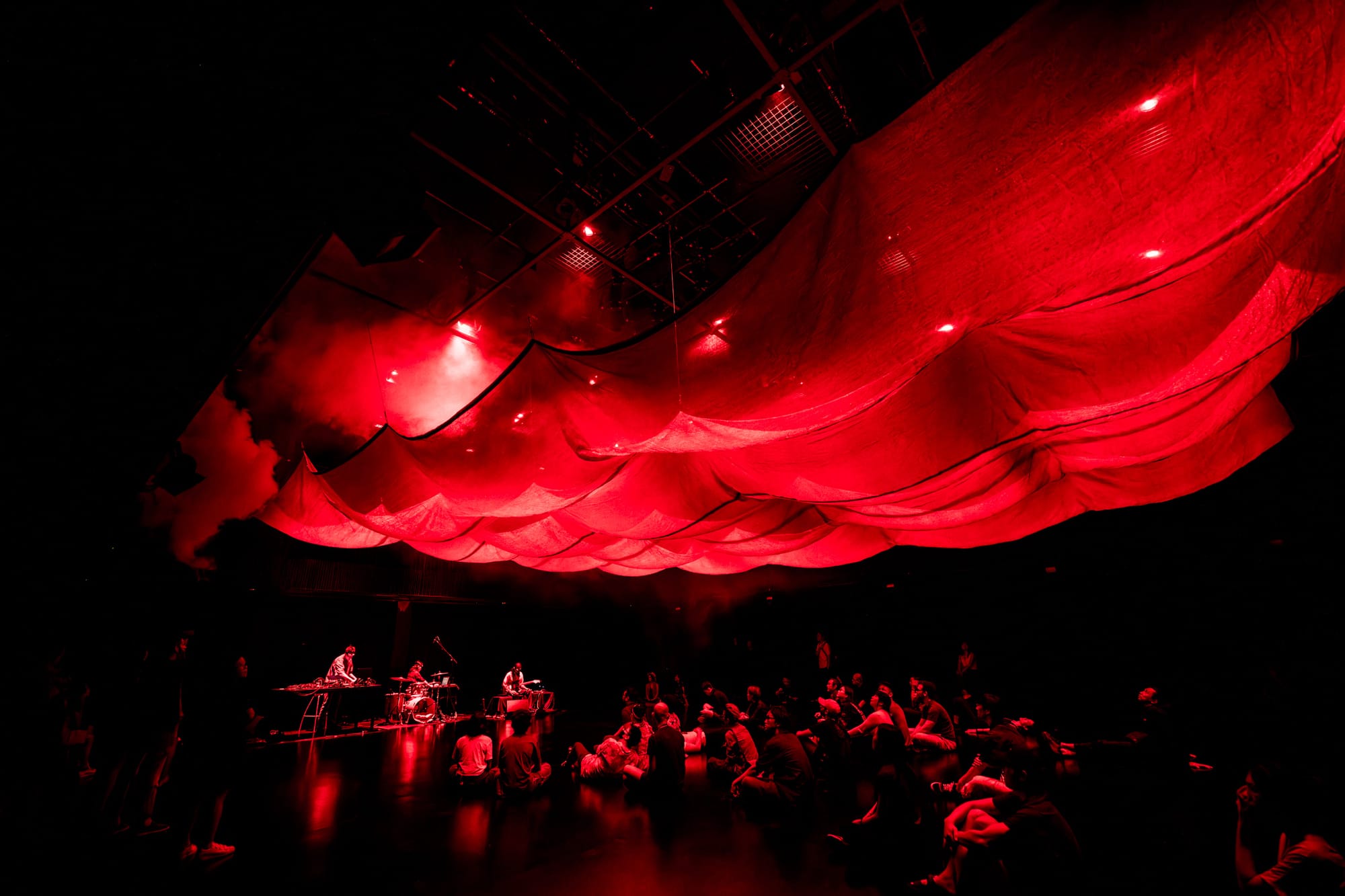
What does it mean for us to become acquainted with Lenggong Valley this way, through “REFUGE”? It is resonant both on a geologic scale, and a deeply personal one, as we partake in a shared exploration in the theatre. “REFUGE” follows “REFUSE” (2022), the band’s inter-media exhibition about music, mushrooms and decomposition. While “REFUGE” is not meant as a sequel, both works delve into the underground, albeit on a different scale and depth. “REFUSE” focused on the mycelial network and, for three months, transformed the Singapore Art Museum’s gallery space into a sprawling ecosystem through a bio-sonification setup that responded to living fungi inhabiting the space. The air was suffused with the earthy scent of spores travelling through every crevice, making known what was previously invisible to the naked eye. These works demonstrate the band’s history of deep listening, and its sensitive and dexterous responsiveness to worlds we often overlook, as it transforms spaces into portals that make tangible realms beyond our attentional reach.
I first encountered The Observatory’s work in 2019 at Playfreely, their annual experimental and improvised music festival. Subtitled “The Transparency of Turbulence”, the festival asks what we reveal of ourselves when we come face-to-face with the “interminable spectre of becoming”. Playfreely gathers artists from across Asia and invites them to converse with each other through a series of aural callbacks and mutual provocations. To my untrained ear, this felt like a group of friends sharing and learning about each other’s languages with curiosity and reciprocity. I had not known music could sound like this: so playful, explorative, and open to being surprised by itself.
Five years later, it seems like the band has found part of an answer through “REFUGE”. We do reveal the softest parts of ourselves. We are shivering, amorphous, bare, apprehensive, playful. We contend with what we’ve revealed with both delight and horror—will we be met with care, or callousness? Through its long-term sonic and spatial investigations, The Observatory has sculpted conditions in which play and freedom is possible for its audiences, including the courage to lean into surprises and uncertainty.
The group’s process reminds me of a fragment of poetry by Lin Ji-Gang, a Taiwanese poet:
有人遺留一架鋼琴
突然下雨的日子
點點滴滴落在鍵盤
沒有經過允許就響起
(食譜:Cadence《餘人》 林季鋼 著)
Someone forsook a lone piano.
On a day of sudden rain,
water fell upon its keys drop by drop and
without anyone’s permission, it sang.
Devouring the score: Cadence from The Remnants by Lin Ji-Gang (Translation by Teo Xiao Ting)
Just as the music in this poem is not created by rigidly dictating how someone should interact with the environment, or the instrument, The Observatory and its collaborators are both the “sudden rain” and “lone piano”. It presents us with a set of conditions through which we are free to meet the work as we are. As Dharma and Cheryl told Plural Art Mag, “there’s no lesson to be learnt” from their work. What we glean is for us to “decide for [ourselves]”. And it is precisely this generosity in creating a world that trusts in serendipitous moments that I am able to access their embodied memories of and associations with the Lenggong caves synesthetically, through music. By making themselves—and us—porous and present to all that we experience, and transmuting all of these experiences into performances that become portals through which we access worlds within and without us, The Observatory and its collaborators sing and resound despite not having “anyone’s permission”, despite perhaps having been “forsaken”.
An intense splay of green moves rapidly above my head. A forest. I’m remembering this point in the performance, but I can no longer place it in linear time. What lingers in my body now is the foliage glittering and filtering through the shade net, turning my skin into fresh mulch. It’s giving me vertigo, as though I’ve been transported into the centrifugal heart of an unknown, unnamed forest, whirling through its leaves and branches as a single atom. There is no sense of up or down, left or right—just green, green, and more shades of green.
The ground beneath me trembles slightly from Cheryl’s insistent rhythms and this time, I feel the sounds instead of just hearing them. Next to me are other atoms, equally transfixed—some have their eyes closed, others are trying to chase the forest with their gaze as it flits above us. Butterflies. I feel butterflies in my stomach—an uncanny blend of excitement and peace as I try to find some kind of emotional footing, before realising I feel safe enough to surrender to the maelstrom of sensations created just for me. I remember the wisdom of the Five of Pentacles: I don’t need to find my footing; what comes after desolation, and being overwhelmed, is the freedom of reorientation. Despite the uncertainties I’d experienced in the past hour, what sparkles in my mind right now is the horror and beauty co-existing in the here-and-now.
As that tiny, single atom, I leap into the unknown—and feel myself holding and held by everyone present with me, and experience something akin to ecstasy and rapture.
Teo Xiao Ting works in intimate and sometimes invisible spaces to sprout worlds that are more joyous, habitable, and honest. Presently, their practice materialises as arts writing, workshop facilitation, and one-on-one therapy sessions. More here: https://txting.space/
“REFUGE” ran from May 31st to June 1st as part of the Singapore International Festival of Arts.
If you enjoy Jom’s work, do get a paid subscription today to support independent journalism in Singapore.
Letters in response to this piece can be sent to arts@jom.media. All will be considered for publication on our “Letters to the editor” page.





